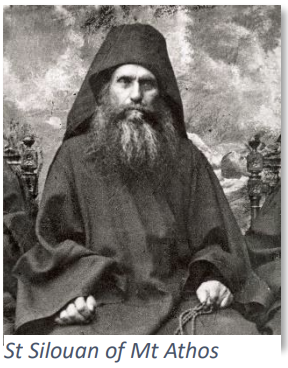Communion Between the Living and the Departed
In our services, we remember the needs of those who are living, and we remember the needs of those who have departed. Many of the litanies conclude with the prayer, “Commemorating our Most Holy, Most Pure, Most Blessed Lady, Theotokos, and evervirgin Mary, and all the saints, let us commend ourselves and each other, and all our life unto Christ our God.” We do with our words what is done with the bread on the altar. We gather everything and everyone together and present them to God.
“No one is saved alone.” This is a common saying in Orthodoxy. It recognizes the fact that the truth of our existence cannot be reduced to our individuality. On the biological and cultural level, the commonality or “communion” of our life is obvious. We come into existence through the union of a man and a woman. We share their DNA. What we inherit from them is a staggering amount of our reality, including major portions of our personality. We are birthed into a culture, permeated by its history. We learn a language that itself contains untold centuries of grammar and words that are themselves the product of a larger humanity. Although each of us must live an individual existence, we are still only giving an individual expression to a life which has its foundation in a common, shared reality.
In the life and teaching of the Church, this understanding extends to almost every aspect of the faith. Our commonality is the language in which salvation itself is described. We are “baptized into Christ.” When we partake of the sacrament of the Holy Eucharist, we understand that Christ “abides in us” and we “abide in Him.” When we speak of Christ’s death on the Cross, we are not describing something He did so that we do not have to do it. We speak, instead, of being “crucified with Him.” In the words of the early Fathers, “Christ becomes what we are that we might become what He is.”
In the words of the early Fathers, “Christ becomes what we are that we might become what He is.”
This way of being carries over into the nature and character of our relationships with others. St. Silouan of Mt. Athos famously said, “My brother is my life.”1 It is a profound understanding of what it means to love. One expression of this love is found in the doctrine of the “Communion of Saints.” The Church is one. It does not consist of two parts–the living and the departed–or in that common phrase the “Church Militant and the Church Triumphant.” The life of the Church is a single, common life that encompasses the whole of its members throughout time, both the living and the departed, those of the present, those of the past, and those who are yet to come.
In the preparation of the bread and wine for the Divine Liturgy, the priest makes special cuts of the bread and arranges it in a symbolic manner on the Discos (plate). At the center is the “Lamb,” the cube of bread that will be consecrated as the Body of Christ. Surrounding the lamb are particles taken from the bread and placed in a manner representing the Theotokos, the Choirs of angels and saints, and all believers, both the departed and the living. This “icon” of the Church is then carried in procession and placed on the altar during the time of the Great Entrance as we sing, “Let us now lay aside all earthly cares…” It is an expression in the actions of the Liturgy of the true commonality and unity of the Church.
Contemporary culture tends to overemphasize the individuality of persons. This comes from a concern to protect the needs and dignity of each person but has often come at the expense of remembering the common life shared by all humanity. Even in science fiction (such as Star Trek), there is a recognition of the tension between the needs of the many and the needs of the few. In the Church, this tension is resolved. It is resolved by understanding that we do not exist as utterly detached, separated entities. Rather, each life co-inheres in all lives, and all lives co-inhere in each life. It is not either-or.
This understanding of our common life is not relegated to the realm of ideas, a theoretical notion to be locked away in a book. In general, the teachings of the Church are brought into our daily practice of the faith that they might truly form and shape our lives. The common life of the Church finds its expression particularly in our prayers.
Footnotes
-
St. Sophrony, St. Silouan the Athonite, trans. Rosemary Edwards (Crestwood: St. Vladimir’s Seminary Press, 2021). ↩